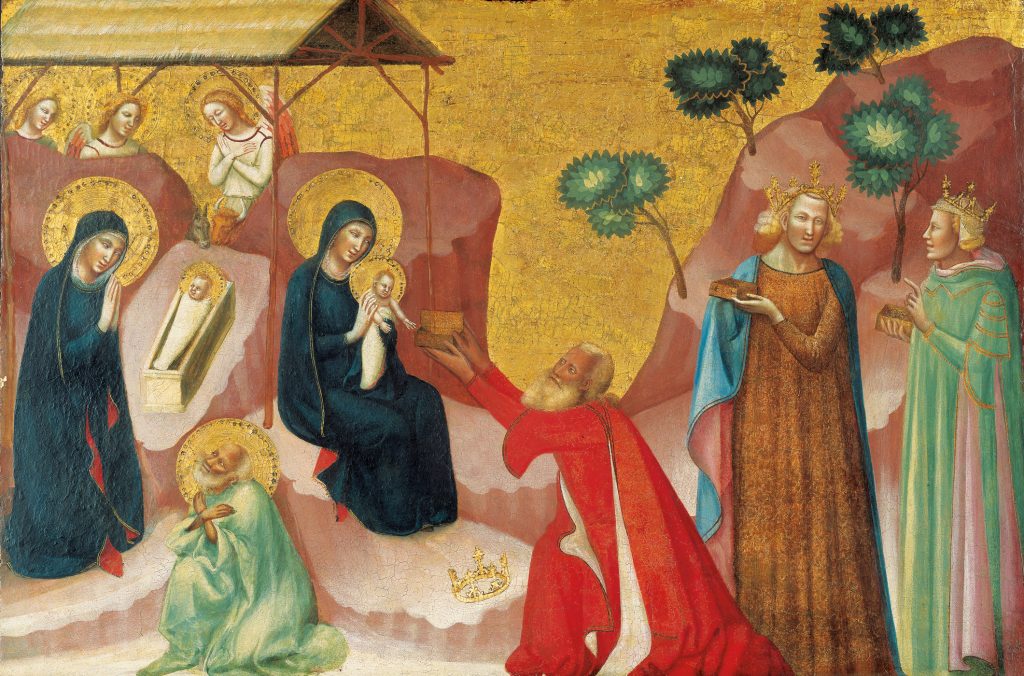Pseudo-Jacopino di Francesco (artist)
The name of this anonymous artist (or perhaps group of artists) is derived from the painter Jacopino di...
ver artistaStudents explore the topics of interpretation and intertextuality by investigating and creating texts and works of art inspired by other texts.

The Nativity and the Adoration of the Magi, by Pseudo-Jacopino di Francesco
The lively expressions and gestures of Pseudo-Jacopino’s figures and the elaborate, stylized patterns and...
1. Show students The Nativity and the Adoration of the Magi by Pseudo Jacopino di Francesco (refer to the Art about Writing (and Pictures) Handout for full discussion). Tell students that this is a painting that the artist based on a pre-existing text: the gospels of Luke and Matthew, in addition to other writings. Give students the source text:
Have students consider:
What similarities and differences can you find between the painting and its source text? What tools does the artist use to tell a story without words?
2. Facilitate a discussion about intertextuality and interpretation.
3. Tell students that they will be assigned a work of art that is intertextual (an artistic depiction of a source text), but they will not receive the source text (see Art and Source Text document). Students will interpret the works of art based on visual information. Assign each student a work of art from the handout (marked A, B, C, etc.). Make sure that students see only the work of art that they will use to start the project.
Follow this pattern when assigning works over the course of the project, as students will exchange work with each other:
In Step Four:
In Step Five:
In Step Six:
4. Have students speculate about the source text by writing a brief version of what they think the source text may be. Begin by asking students to investigate the visual evidence offered by their work of art. Students may recognize the source text based on prior knowledge and use that prior knowledge when completing the assignment. Have them consider questions that help interpret visual information, such as:What is going on in the picture? What do you see that makes you say that?What story is depicted here?Who are the people? What does their appearance (clothes, faces, etc.) tell you about them? What are they doing?Where are they (location and time period)?What is the most important part of the painting? How do you know?What conclusions can you draw from this work of art?
Tell students to write a reflective entry in their process journal to create a record of their thoughts at this point in the project.
5. Put the students in groups of three to exchange their stories. Remember that students should be familiar only with the work of art that they were assigned, not the ones their peers were assigned. Have students create a work of art based on their peer’s writing. Drawings, collage, and computer imaging programs can be used to create the works of art depending on the students’ comfort level with various media. Ask students to reflect on the process of creating art in their process journal.
6. Tell students to exchange their work of art with the third member of the group. Repeat Step 4 using the students’ work of art instead of the original work.
7. Display printouts of the original works of art on the wall or a bulletin board with the actual text from the handout. Have students place their stories and art with the original work. As a class, compare the different versions of the stories and art. Discuss:
Comparing the source text with original work of art and writing from Step 4: How did the original artist choose to interpret or depict the source text? How did those decisions influence the way that you interpreted the art? How similar or different were the first student stories from the actual text?
Creating a work of art: What decisions did you have to make to create a work of art based on your peer’s story? For example: Which characters did you show? How did you dress them or select their hair color? How did you determine what parts of the story you could tell visually? How did you show actions? What were the most effective tools for telling a story visually? How are these choices subjective? How did the choices affect meaning and interpretation?
Compare the second student story with the works of art and texts: How similar or different were the second student stories from the previous texts? How do texts change as they are interpreted multiple times?
8. As a conclusion, have students look over their entries in their process journals from the course of the project. Ask students to write an entry summarizing how their thinking developed over the course of the project.
Escrito por Jill Taylor, educadora de la NCMA
The discussion, writing, and art activities may be used to determine students’:
Vocabulario
intertextuality
interpretation
Materiales
The name of this anonymous artist (or perhaps group of artists) is derived from the painter Jacopino di...
ver artista